Aloe Vera plants thrive best in a warm and dry climate. If you are a beginner, you might have overwatered your Aloe vera. It is the most common and dangerous issue that can even kill the plant.
Frequent watering without checking the soil leads to overwatering, and if overwatering is prolonged, it leads to root rot. To save your aloe vera plant from mild overwatering, stop watering it and wait for the soil to dry out. For severe overwatering conditions, you have to repot the Aloe.
Most beginners can face the problem. But don’t worry, as this article will give you in-depth knowledge about how to save an overwatered Aloe Vera plant with the right steps.
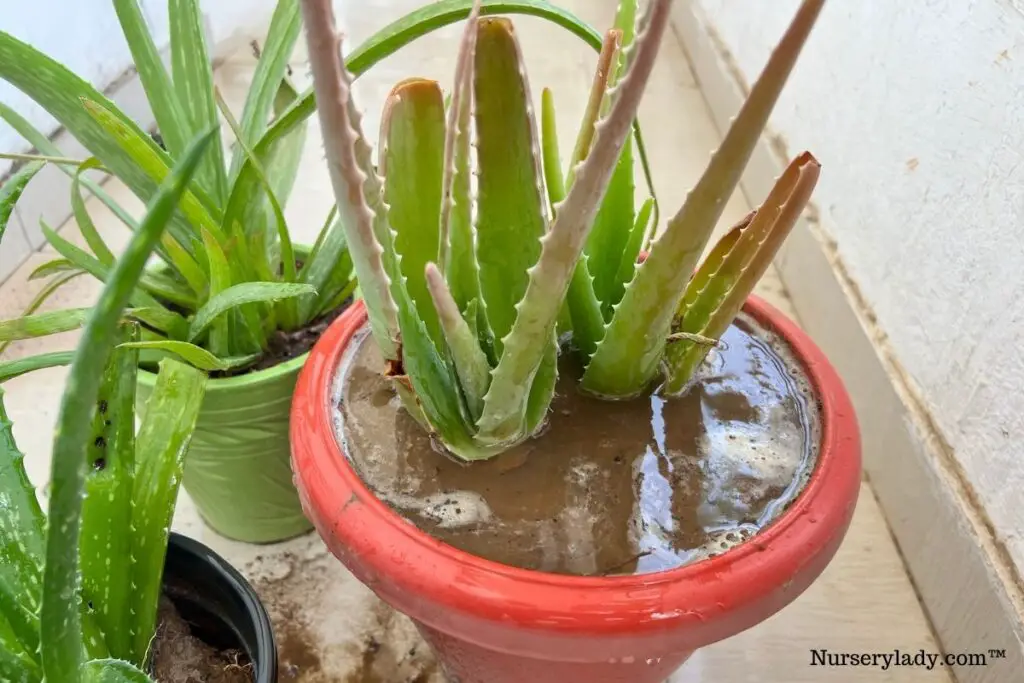
Why is my Aloe vera getting overwatered?
Generally, we are only aware of 1-2 reasons behind an overwatered Aloe Vera plant.
But, there is more.
Some of the reasons are common: the owners try to keep the plant happy but unknowingly push them towards stress.
Frequent watering
Many people consider Aloe Vera plants as any other normal plants that require daily watering.
But, being a succulent, Aloe Vera doesn’t require daily watering because it can store water in the leaves utilized during dry weather.
Besides, Aloe Vera is native to the arid and desert areas of the Arabian Peninsula.
Watering frequently without letting the soil dry will only lead to overwatering.
You must mimic the plant’s dry growing conditions.
Also read: How To Water Aloe Vera Plant? (How often, Summer, Winter)
No drainage in the container
If you are planting an Aloe Vera plant in your garden, ignore this point.
A container should always have drainage holes for the flowing out of the excess water after watering.
If a pot fails to have a drainage system, the water stays stagnant in the soil.
Most of the time, the soil and roots remain wet, and the plant gets overwatered faster in such conditions.
You can solve the problem by using a container with a proper drainage system.
The soil is highly moisture-retentive
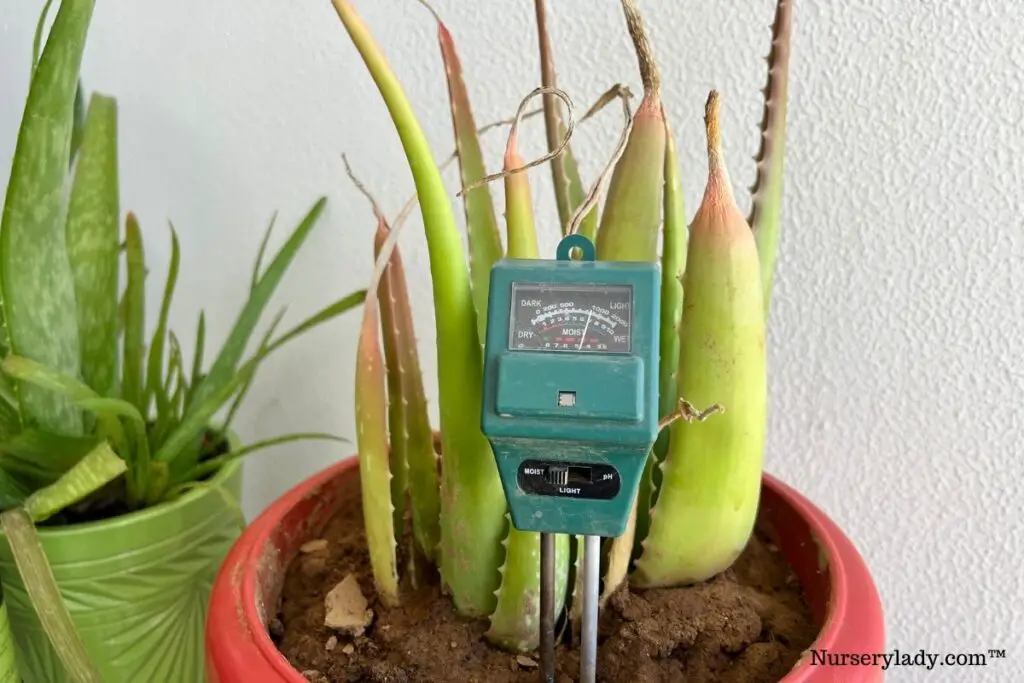
You are watering correctly, and the container also has drainage holes.
But still, the plant displays signs of overwatering.
The soil is the culprit here.
Since Aloes enjoy dry conditions, the soil must be well-drained and lightweight.
It should retain moisture too, but not for prolonged periods.
If the soil doesn’t drain water quickly, it stays wet and keeps the roots wet.
The problem will get resolved by using a cactus potting mix.
Or you can also make your potting mix by adding porous materials like perlite, pumice, and coarse sand in equal parts.
Also read: What Type Of Soil For Aloe Vera Plant? (+Ideal Soil Mix)
Looking for gardening supplies? We have tested 100's of products before recommending them to you guys. Check out our best pick below:
| Image | Gardening Supplies | Best Price? |
|---|---|---|
 Top
Top Top
Top | Raised Garden Bed Kit | Check On Amazon |
 | XLUX Soil Moisture Meter, Plant Water Monitor, Soil Hygrometer Sensor for Gardening, Farming, Indoor and Outdoor Plants, No Batteries Required | No Results |
 Top
Top Top
Top | 82 Pcs Garden Tools Set and Extra Succulent Tools Set | Check On Amazon |
 | Joeys Garden Expandable Garden Hose with 8 Function Hose Nozzle, Lightweight Anti-Kink Flexible Garden Hoses, Extra Strength Fabric with Double Latex Core, (50 FT, Black) | No Results |
 Top
Top Top
Top | Dual Chamber Compost Tumbler | Check On Amazon |
 Top
Top Top
Top | Sunnyglade Plant Stakes | Check On Amazon |
 Top
Top Top
Top | Organic Cold Pressed Neem Seed Oil | Check On Amazon |
 Top
Top Top
Top | Mighty Mint Gallon :-Insect and Pest Control Peppermint Oil | Check On Amazon |
 Top
Top Top
Top | Scotts DiseaseEx Lawn Fungicide | Check On Amazon |
 Top
Top Top
Top | Jacks Classic 20-20-20 All Purpose Fertilizer | Check On Amazon |
 Top
Top Top
Top | 30,000 Seeds Pollinator Attracting Wildflower Mixture | Check On Amazon |
 Top
Top Top
Top | Survival Vegetable Seeds Garden Kit-Over 16,000 Seeds | Check On Amazon |
Climate
Aloe Vera doesn’t like high humidity.
They are native to dry areas, and they enjoy low humidity ranging between 20 and 50%.
If the humidity around the Aloe Veras is high, the moisture will increase automatically, and the plant will lose the moisture very slowly.
You can only prevent it if you change your watering routine accordingly.
But if you continue the usual watering, it will result in overwatering and fungus development.
Lowering the humidity is essential.
Also read: Can Aloe Vera Plants Survive Cold Weather? (+Deal With Cold Damage)
The size of the container
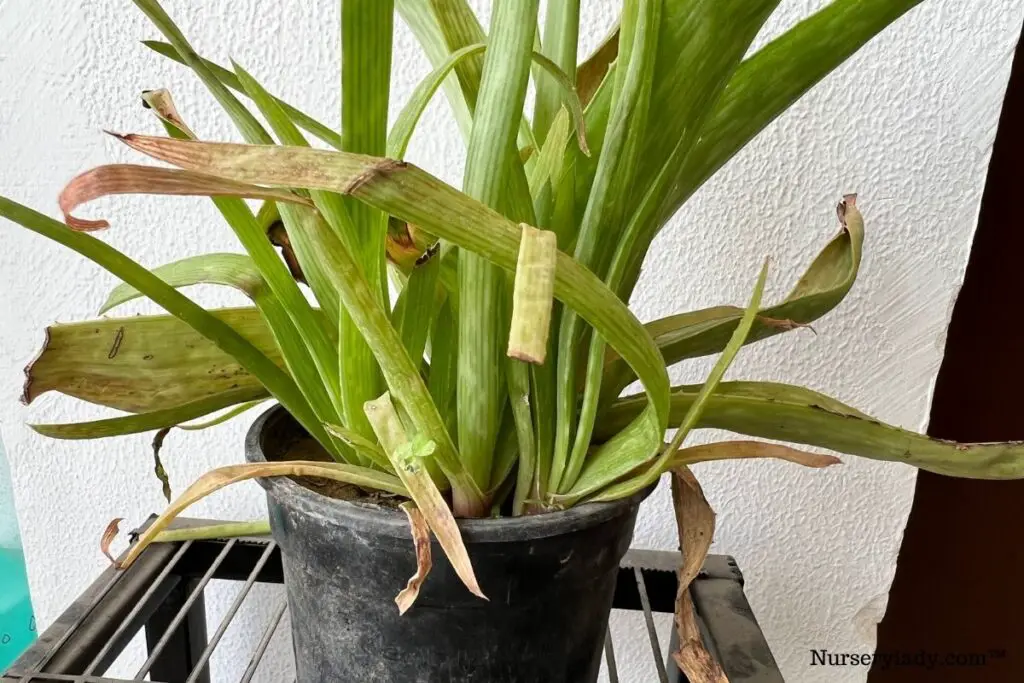
Aloe Vera needs a planter that is 1/3rd larger than the size of the plant.
For repotting an Aloe Vera, you must use a container that is only 1-2 inches bigger than the old one.
And, it should be a wide pot, not a deep one.
It is tempting to choose a big container because it will give the roots extra room to spread.
The plant can also deliver multiple pups without any issue.
But, a large or deep container will need more soil. When watered, the soil will take a long time to dry.
As a result, the roots will again stay damp for lengthy periods and make them suffer.
Also read: What Pot Is Best For Aloe Vera Plant? (Pot Type, Size & More)
What does an overwatered Aloe Vera plant look like?
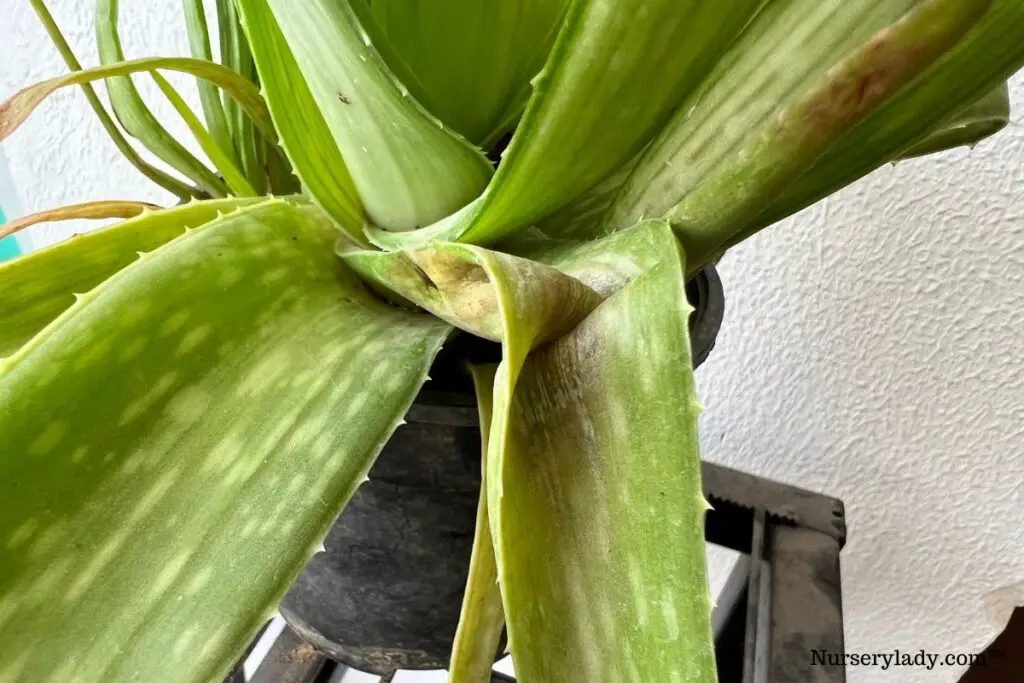
When you overwater an Aloe Vera plant, the leaves will lose their color and become droopy, soft, and mushy.
These are the evident signs of overwatering.
When they are not in good health, they will always tell you with symptoms:
- Yellow leaves, especially at the bottom
- Leaves get soft and mushy.
- The stems, too, get softer.
- The outer and bottom leaves turn brown.
- Leaves get blisters all over due to excessive water consumption, signs of edema.
- Soil growing mold. It happens when dampness is accompanied by high humidity.
Difference between overwatering and underwatering
If you are a beginner at gardening, you should know that the signs of both these problems are more or less the same.
It is very confusing to understand the exact issue.
You might give the wrong treatment and end up killing the plant.
The common signs are discoloration and droopiness.
Don’t worry, as we will tell you how to differentiate overwatering and underwatering.
| Overwatering | Underwatering |
|---|---|
| Leaves droop and have a mushy feeling | The leaves droop and fall over the container’s edge |
| The leaves lose their green color | The leaves feel dry and thin |
| The soil remains wet | The soil remains dry and compact |
| The soil releases a foul smell | The edges of the leaves will have dry and desiccated brown spots. |
| The root ball rots and becomes mushy and dark brown. | When you take the plant out of the container, the roots look dry and brittle. The soil seems powdery. |
Can I save an overwatered Aloe Vera plant?
It is tricky to answer the question.
Whether an overwatered Aloe plant can be saved or not depends on the level of damage and how fast you take the right action.
Aloe Veras are charming and hardy plants.
So, never leave the expectancy of trying to improve the plant’s health.
The best way to treat the problem is the close and regular observation and quick action.
Now, let’s get into the steps of saving an overwatered Aloe Vera plant.
How to save a severely overwatered Aloe Vera plant?
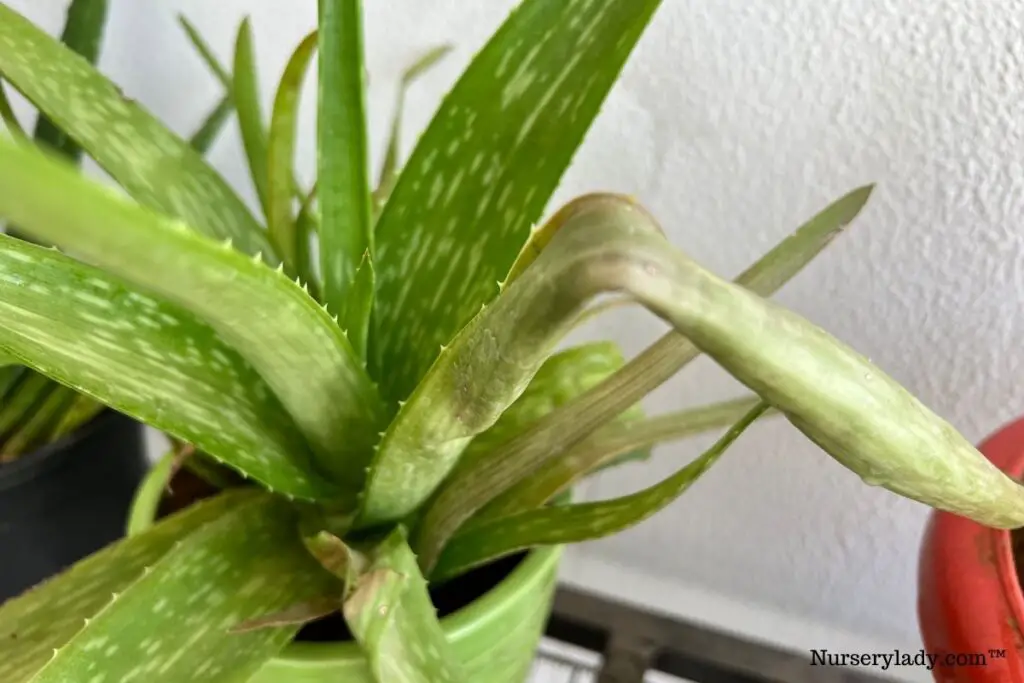
Droopy leaves with a feeling of mushiness and sogginess are the common signs of overwatering.
You can solve the problem with some simple techniques.
When the plant is not doing well, it shows these signs to tell you that they are ill.
Here is a step-by-step guide to reviving a severely overwatered aloe vera plant:
- Take the Aloe out of the container. Remove the soil from the roots with a brush or chopstick.
- After you take it out, you should let the plant dry out, especially the roots. They have remained wet for a long time due to overwatering. Drying will take at least 2-3 days.
- Cover the roots with a paper or newspaper and keep them away from the direct sun. The temperature must be cool but not below 41°F.
- Now, after the roots are dry, check the condition of the roots closely. You have to cut off the damaged roots. The damaged and rotten ones are dark brown and mushy.
- Get rid of the brown and mushy roots. Remove until no damaged parts are seen in the plant.
- After the pruning is over, sprinkle some fungicide over the root portions. It will prevent the chances of further fungus development.
Now, it’s time to repot the plant.
You can plant it in the ground.
But it is better to place it in a container.
Once it is well-established, you can shift it to the ground.
- Take a clean container. If your plant has not overgrown, use the same pot. But, if it’s overgrown, use a container 1-2 inches bigger than the old one.
- If you use the same old container, clean it. Mix 1 part of bleaching powder with 9 parts of water and wash the container with it. You can also use soapy water. Let it dry for some time.
- Use a container that has enough drainage holes. If it’s a single hole, it should be big enough for an easy passage of one finger. Or, there should be multiple small holes.
- Now, prepare a new soil mix. Add 50% potting soil with 50% stones of various sizes, like river rocks, natural gravel, pebbles, outdoor decorative stones, etc. You can also use perlite and coarse sand. It helps in drainage significantly.
- Now, fill in half of the planter with the soil mix, place the plant in it and cover the surrounding with the remaining soil.
- Don’t place the plant under the direct sun for a few weeks. Keep them under bright indirect sunlight and avoid watering for some days until the soil gets dry.
- You will see signs of recovery within a few weeks. The plant won’t look weak and will grow new leaves. Once you see signs of revival, resume normal watering and gradually expose it to sunlight.
How to save a mildly overwatered Aloe Vera plant?
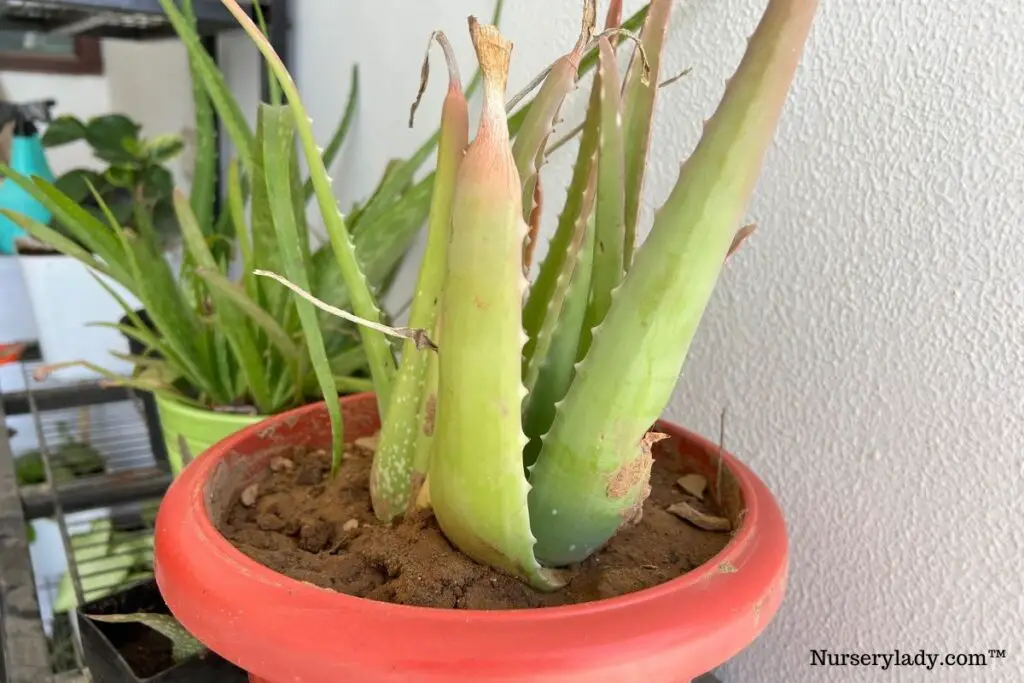
If you have recently overwatered your Aloe Vera plant, you will see mild symptoms in the plant.
For example, the leaves are pale and droopy, and the soil is cold and wet.
If you take measures at such an initial stage, you can prevent them from getting overwatered heavily.
Let’s look at the steps of saving a mildly overwatered aloe vera plant.
- First, stop watering for some days and wait to see how the plant reacts. Since these succulents like dry weather and store water in the leaves, they will stay without water for a very long time.
- If your plant is in a container, make sure it has drainage holes.
- Also, ensure that the pot is not standing over a saucer filled with water. Always empty the saucer after the planter stops dripping water from the drainage holes.
- Check the soil condition. Allow the soil to dry out before each watering.
- Shift the plant to an area with indirect or partial sunlight. Since they are already stressed, the harsh sun can weaken the plant and increase recovery time. But don’t shift them to a dark spot. Without light, the soil won’t dry quickly.
- Once you find the soil has dried and the plant is recovering and improving, you can give them some direct morning sun for 3-4 hours.
- You can also start with the correct watering technique. We will share it later on.
What should I do if my overwatered Aloe Vera plant is impossible to save?
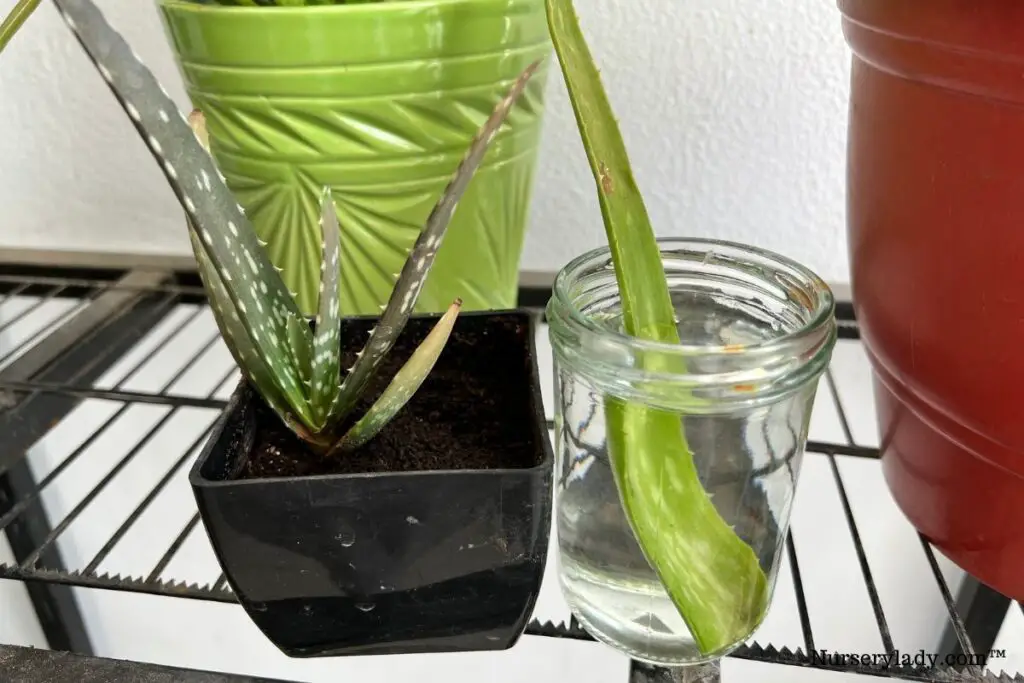
It will be impossible to save the Aloe Vera plant if overwatered at an extreme level.
But, there are still chances of getting the Aloe Vera plant back by propagation.
Look for the pups of the Aloe Vera at the base of the plant.
They will measure at least 1/4th or 1/5th size of the mother plant.
You can separate them and plant them in well-drained soil.
Separate the pups carefully using a disinfected knife.
Plant the pups in a container with well-drained soil and keep the soil slightly moist.
Since the Aloes can store water, you can start watering after a few days.
Don’t pour water directly on it, as that can cause overwatering and kill the pups.
Start with less water. Keep them in a location with indirect sunlight.
Once the plant is well-established, start normal watering and shift them to direct sunlight.
Within a few months, these pups will become the clones of their mother plant.
Many people try propagating them in water.
But it might not give good results as they are recently saved from an overwatered plant.
It will again rot them.
If your plant doesn’t have any pups, you have to look for some healthy leaves for leaf propagation.
Remove the healthy leaves from the plant.
Leave the cutting for some days to form callous and spray some fungicide to avoid any fungus development due to cutting.
Never directly place the trimmed leaf in the soil as that will rot the leaf.
Once your leaf has formed callous, plant them in well-drained soil.
Water the soil by misting and keep the leaf near indirect light.
Soon it will start to grow roots.
What is the ideal water content for Aloe vera?
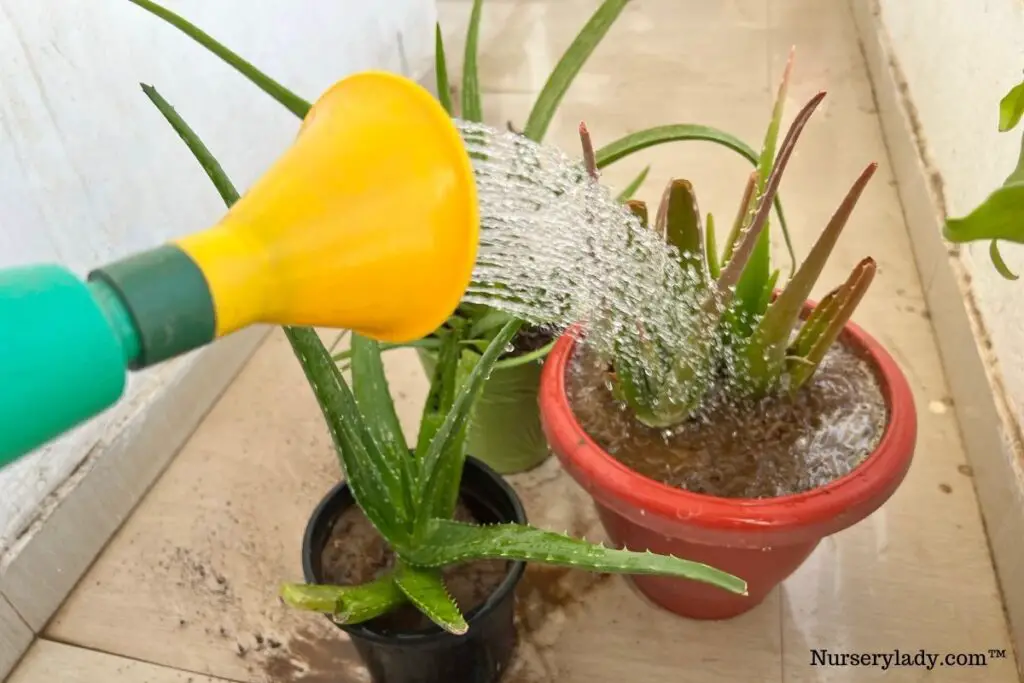
Maintaining the right water level in the Aloe Vera plant is the only way to keep the plant happy.
It is easy to excel in watering, but still, most gardeners will overwater them.
Let’s see how to do it.
- To manage the exact water content, you should know how much moisture the Aloe Vera can handle and then provide them as per their need.
- As you know, Aloe Vera is a succulent native to the desert areas of North Africa and the Arabian Peninsula. This gives us a hint that Aloes don’t require much watering.
- Aloes being succulents also confirms that their thick leaves can store water. So, it is clear that they don’t require frequent watering.
- Let the soil dry out between each watering. At least the top 2-3 inches of the soil should remain dry, especially around the roots.
- The best way to understand the watering needs of Aloes is to check the moisture level of the soil.
- Buy a moisture meter if you fail to feel the moisture level right of the soil with your finger. That will give a reading about the moisture level.
- Then you can provide them with water accordingly.
How to water the Aloe Vera plant?
- Generally, you should water the Aloe Veras once every 2-3 weeks. This routine may differ depending on various conditions throughout the year.
- You must water the plant close to the soil and soak the soil properly. If your plant is in a container, continue watering until it starts draining out. Avoid splashing water on the leaves.
- You must use distilled water or rainwater. Never use tap water directly as it contains harmful minerals that can damage the plant. Let the tap water sit overnight before you use it.
- If you are using a saucer, check and empty it from time to time to prevent the container from sitting in a pool of water. Otherwise, the roots will be wet through the drainage holes and arise overwatering issues.
Common mistakes to avoid while watering Aloe vera
- Never water the Aloe Vera from above. Water splashing in the leaves can make the leaves soft and mushy. If you want to clean the leaves, wipe them with a cloth.
- Never use cold water or hot for the Aloes. Always use tepid or room temperature water.
- You must keep the soil almost dry most of the time during the winters.
- To save them from overwatering, don’t end up dehydrating your plant. Give them the required water they need for optimal growth.
- Never water Aloes every day or more than once a week. Water them once every 2-3 weeks. Let the soil dry before watering.
Final thoughts
It must be clear to you how you can save the Aloe vera and prevent overwatering. It is not a difficult job to maintain the right watering routine. It is also easy to revive the plant back to life if the right steps are taken quickly.
If you follow the tips I have shared for the right watering and avoid the common mistakes, you can prevent the plant from getting overwatering. You don’t have to worry about your Aloe Vera plant and its water requirements. With little practice daily, you will master it quickly.
Reference: NCBI, New York Botanical Garden, University of New Hampshire, University of Florida, Wikipedia.
